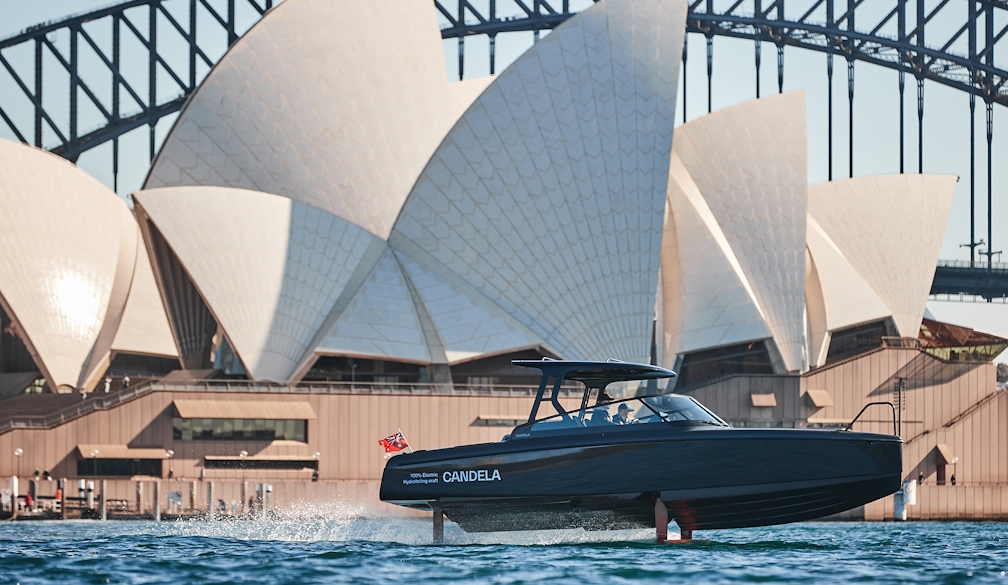World's Best Hydro-foiling Electric Powerboat Arrives in Sydney

The first all-electric powerboat to challenge diesel and petrol-powered equivalents has arrived in Sydney Harbour.
Brought to Australia by maritime pioneer Carbon Yachts, the Candela C-8 is the fastest long-range electric powerboat available, reaching up to 30 knots and covering 57 nautical miles. The vessel uses computer-controlled hydrofoils to lift it above the water’s surface enabling the boat to “fly” which reduces resistance and minimises wake and allows it to consume 80% less energy than conventional boats of similar size.
The C-8’s electric motor is housed in a pod beneath the surface, enabling the vessel to operate in near silence even at speeds exceeding 20 knots. Advanced sensors and computers continuously adjust the hydrofoil’s angle of attack—up to a hundred times per second—to maintain stable flight height and balance. Additionally, the vessel is equipped with a 69kWh power pack from Polestar, allowing it to be fast-charged in just 30 minutes.
These unique features have made the C-8 the world's best-selling electric leisure boat and earned it the title of 2023 European Boat of the Year. Carbon Yachts Mary Bickley says it’s a genuine industry game changer.
“Combining cutting-edge technology with a commitment to sustainability, the C-8 represents the future of boating. It offers a dramatic improvement in comfort when compared with conventional powerboats,” she said.
“We believe that the C-8 can redefine the boating experience for Australian enthusiasts as well as engaging an entirely new market.”
Carbon Yachts will showcase the C-8 at the Sydney International Boat Show, which begins on 1 August and runs until 4 August. Show attendees will be offered a first-hand look at the craft, including demonstrations of its innovative design features and superior performance, along with exclusive daily test “flights” on Sydney Harbour.
The C-8’s arrival follows the installation of Australia's first fast-charging station for electric boats. Installed at Sydney’s Pittwater, it’s the first piece of infrastructure that will enable Sydney residents to use electric boats viably and is the first of a dozen planned along the East Coast.
Mary Bickley says there’s been a surge in interest in electric boats across Australia.
“The C-8’s design and performance have set a new standard for innovation within the marine industry, highlighting the potential for electric boats to offer luxury, performance and sustainability.”
The company behind the C-8 is Swedish electric boat maker Candela. Established in 2014, it is widely recognised as a global electric maritime technology and manufacturing leader. It also makes the world’s first electric “flying” passenger ferry, the P-12.
The vessel uses computer-controlled hydrofoils to lift it above the water’s surface, reducing energy consumption and minimising wake. The P-12 seats up to 30 passengers, has a top speed of 30 knots, a range of 50 nautical miles, and cuts operational costs in half compared with conventional diesel boats. It entered service in Stockholm earlier this year as part of a nine-month pilot.
Candela founder and CEO Gustav Hasselskog said hydrofoils are the key to cracking the code for electric-powered, long-range, high-speed travel on the water.
“We set out to make the first no-compromise electric boat with maximum range and speed, but we ended up with a new and improved class of craft, which also happens to be electric,” he said.
“It’s a far superior experience to old-school hulls with combustion engines. Boaters no longer must contend with vomit-inducing pitching and slamming or the deafening roar from revving outboard engines. It's hard to return once you’ve experienced flying above the surface in absolute silence.”
“Sydney is also an ideal place for our P-12 ferry. We could easily electrify waterborne transport here, offering faster journeys for passengers and lower costs for the operators.”







